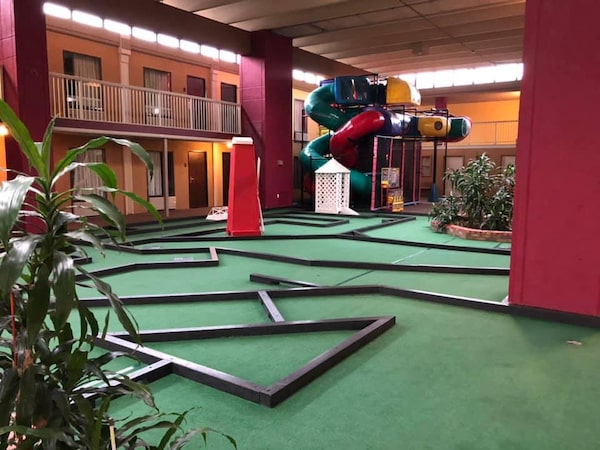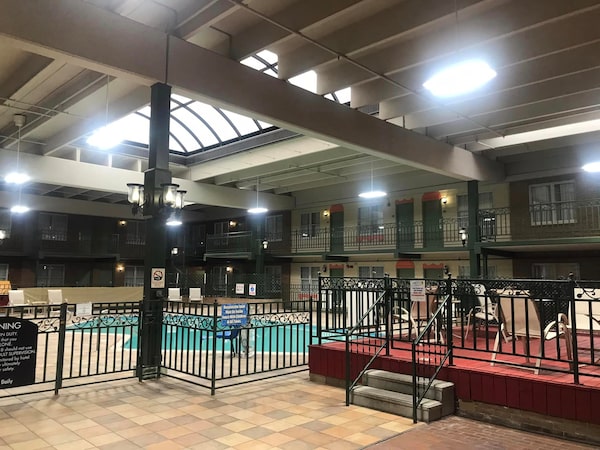
Holidomes are mostly a memory and very few are left standing.
Remember the Holidome?
They were hotels with enclosed courtyards and massive, indoor recreation centres that included tropical-themed décor, kidney-shaped pools, mini-golf, billiard tables, tiki bars, table tennis and shuffleboard.
In the 1970s, Holiday Inn built a number of these leisure-oriented hotels marketed toward families but with amenities that would appeal to grown-ups as well as kids – early versions of fun palaces similar to the Great Wolf Lodge Water Park Resort model in Niagara Falls, Ont.
People still want fun and games, just not necessarily at a domed roadside hotel.
— Jane Domenico, senior vice-president and national lead, retail services at Colliers Canada
The concept flourished until the early 1980s and spawned non-Holiday Inn imitators in Canada, such as the Wheels Inn in Chatham, Ont., eventually replaced with a convention centre in 2011.
Today, Holidomes are mostly a memory and very few are left standing. They have either been rebranded or renovated and bear only a faint resemblance to the stately pleasure domes of the leisure-suit and disco era.
“The idea of these leisure properties more or less peaked during the era of the traditional family, a mother and father and the kids,” says James McKellar, professor of real estate and infrastructure at York University’s Schulich School of Business in Toronto.
“The demographics have moved on. Households are smaller, there are a lot more elderly people and there are a lot more single people,” Dr. McKellar says.
“They were originally called ‘Fun Domes,’” says Ross Walton, writer and historian for the University of Southern Mississippi’s Center for Oral History and Cultural Heritage. “Holiday Inns started in 1952. They had a policy that every 20 years the properties [which were franchised] had to be either renovated or somehow renewed.”
The solution was simple. “A lot of the franchise owners had U-shaped buildings with a pool in the middle, and two partners in Kansas City who had Holiday Inns, Robert Brock and Edwin Linquist, came up with the idea of enclosing the courtyard,” Mr. Walton says.
“[Holidomes] came at a perfect time for the hotel industry, during the energy crisis,” he adds. Fuel prices shot up dramatically after the Arab oil embargo of 1973 and during the Iranian revolution of 1979.
“There were fuel shortages, and people who wanted a getaway had to stay closer to home,” Mr. Walton says.
Holidomes flourished not only because they offered escape but also because the idea was consistent with the Holiday Inn brand, Mr. Walton adds.
The idea was the self-contained vacation. “You could stop at a Holiday Inn at that time and do everything – they had hairdressers, restaurants, gas stations, so indoor entertainment made sense too,” he says.
“Leisure travel now is much more global. At one time you’d get in your car to go somewhere, but then we saw the rise of discount airlines and packages, and people started to travel farther afield,” Dr. McKellar says.
People still want to hop in their cars and enjoy a little fantasy fun on their road trips, but their tastes have evolved since the Holidome days, says John Belknap, co-owner of Penny’s Motel in Thornbury, Ont.

Holiday Inn built a number of leisure-oriented hotels marketed toward families but with amenities that would appeal to grown-ups as well as kids.
He and his partners renovated the 13-room motel to offer escape amenities that might appeal more to 21st-century tastes – an extensive wine list, an oyster bar and an open-air courtyard where guests are encouraged to mingle by an open fire.
“We could have put a swimming pool in the courtyard, but why? We’re just a few steps from Georgian Bay, and the amenities we want people to enjoy are the ones in the area – swimming and boating in the summer and skiing in the winter,” Mr. Belknap says.
His co-owner Drew Sinclair, who is also principal of SvN Architects + Planners in Toronto, says that Holidomes were also victims of rising maintenance costs.
At many Holidomes, the humidity from the indoor pools would damage the domed ceiling and make the inner-courtyard-facing rooms damp and stuffy, he explains.
“While the maintenance of these domed structures is really costly, they’re very easy to demolish, and you still can keep the hotel,” Mr. Sinclair explains.
Insuring Holidomes also became more and more costly, Mr. Walton adds, and the Holiday Inn chain started to rethink its marketing after changes in corporate ownership and a failed hostile takeover bid in the 1980s by a developer named Donald Trump.
The local pleasure escape idea is still going strong, but it’s different now.
“There are places like Great Wolf Lodge,” Mr. Sinclair says. “They focus on one type of activity – in their case, swimming – and they’re near other tourist attractions.”
Amusement getaways are more connected to shopping now than to overnight stays, says Jane Domenico, senior vice-president and national lead, retail services at Colliers Canada.
“Holidomes look like they were great in their time,” she says. “People still want fun and games, just not necessarily at a domed roadside hotel.”
Increasingly, people are going to malls with indoor amusements to get their kicks, rather than hotels with domed indoor recreation centres.
“There are malls with entertainment and amusements in Quebec City, Toronto, Cambridge, Ontario and West Edmonton Mall [which includes the Fantasyland Hotel],” she says.
“And of course, there’s Las Vegas.”